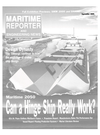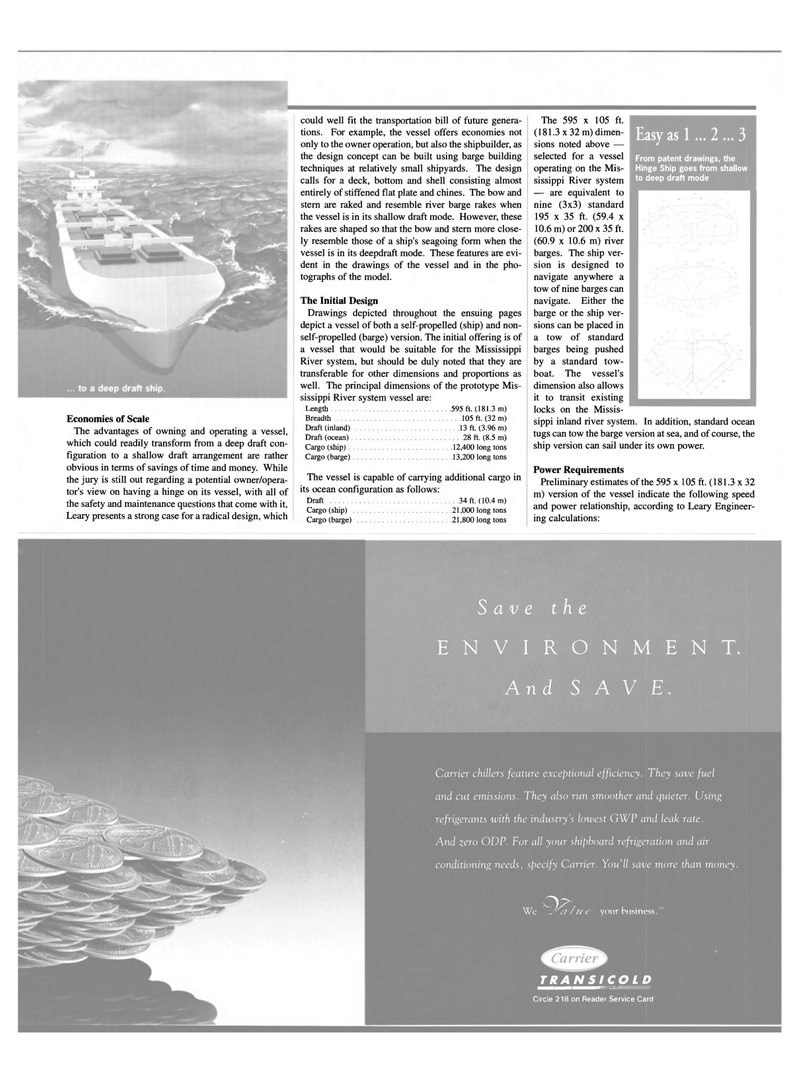
Page 41: of Maritime Reporter Magazine (September 2000)
Read this page in Pdf, Flash or Html5 edition of September 2000 Maritime Reporter Magazine
could well fit the transportation bill of future genera- tions. For example, the vessel offers economies not only to the owner operation, but also the shipbuilder, as the design concept can be built using barge building techniques at relatively small shipyards. The design calls for a deck, bottom and shell consisting almost entirely of stiffened flat plate and chines. The bow and stern are raked and resemble river barge rakes when the vessel is in its shallow draft mode. However, these rakes are shaped so that the bow and stern more close- ly resemble those of a ship's seagoing form when the vessel is in its deepdraft mode. These features are evi- dent in the drawings of the vessel and in the pho- tographs of the model.
The Initial Design
Drawings depicted throughout the ensuing pages depict a vessel of both a self-propelled (ship) and non- self-propelled (barge) version. The initial offering is of a vessel that would be suitable for the Mississippi
River system, but should be duly noted that they are transferable for other dimensions and proportions as well. The principal dimensions of the prototype Mis- sissippi River system vessel are:
Length 595 ft. (181.3 m)
Breadth 105 ft. (32 m)
Draft (inland) 13 ft. (3.96 m)
Draft (ocean) 28 ft. (8.5 m)
Cargo (ship) 12,400 long tons
Cargo (barge) 13,200 long tons
The vessel is capable of carrying additional cargo in its ocean configuration as follows:
Draft 34 ft. (10.4 m)
Cargo (ship) 21.000 long tons
Cargo (barge) 21,800 long tons
Easy as 1... 2 ... 3
From patent drawings, the
Hinge Ship goes from shallow to deep draft mode
The 595 x 105 ft. (181.3 x 32 m) dimen- sions noted above — selected for a vessel operating on the Mis- sissippi River system — are equivalent to nine (3x3) standard 195 x 35 ft. (59.4 x 10.6 m) or 200 x 35 ft. (60.9 x 10.6 m) river barges. The ship ver- sion is designed to navigate anywhere a tow of nine barges can navigate. Either the barge or the ship ver- sions can be placed in a tow of standard barges being pushed by a standard tow- boat. The vessel's dimension also allows it to transit existing locks on the Missis- sippi inland river system. In addition, standard ocean tugs can tow the barge version at sea, and of course, the ship version can sail under its own power.
Power Requirements
Preliminary estimates of the 595 x 105 ft. (181.3 x 32 m) version of the vessel indicate the following speed and power relationship, according to Leary Engineer- ing calculations:
Economies of Scale
The advantages of owning and operating a vessel, which could readily transform from a deep draft con- figuration to a shallow draft arrangement are rather obvious in terms of savings of time and money. While the jury is still out regarding a potential owner/opera- tor's view on having a hinge on its vessel, with all of the safety and maintenance questions that come with it,
Leary presents a strong case for a radical design, which
Save the
ENVIRONMENT.
And SAVE
Carrier chillers feature exceptional efficiency. They save fuel and cut emissions. They also run smoother and quieter. Using refrigerants with the industry's lowest GWP and leak rate.
And zero ODP. For all your shipboard refrigeration and air conditioning needs, specify Carrier. You'll save more than money. m We y 'a/ue your business.
TRANS/COLD ••••••••••Ki?" S ~~
Circle 218 on Reader Service Card

 40
40

 42
42
